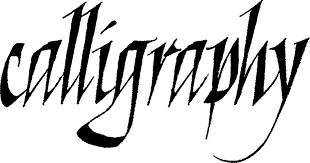By 1451 Johan Gutenberg had already printed his first 42-line Bible in Mainz, Germany.
While this significant event was dramatically changing the way people communicate, the Italian artist, scribe and calligrapher named Ludovico Arrighi continued to stand by and practice his own Chancery Cursive.
This beautifully slanted form of writing is sometimes referred to as the original italics, however you know it better as Calligraphy.
Not as easy as it looks
The beauty of letterforms as created by the human hand look effortless. Some artisans can dip their pens or quills into ink and simply write. The rest of us must put forth some toil.

While producing this article on calligraphy I dug out my old steel brush set, and was parcticing up on my 'hand' to bring you some nice lettering. What I didn't expect was that the old saying: "Use it or Lose It" is true. I haven't done calligraphy for several years and I am so rusty that the results are somewhat less than spectacular.
What to do? Well, since some of you have probably never touched a steel brush, I figured it might be better for me to demonstrate how a rusty artist might still accomplish nice calligraphy without having to spend hundreds of hours getting back into the swing of things!
... working with Bernhard calligraphy
Back to The Typography Department